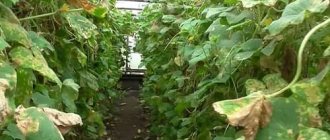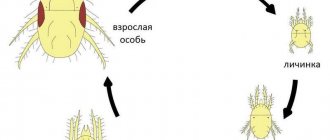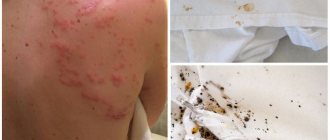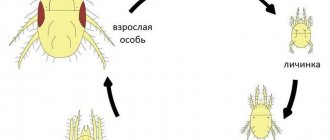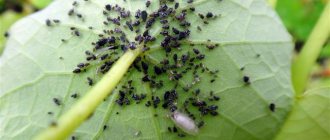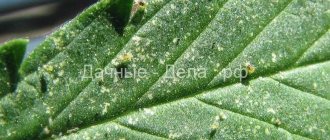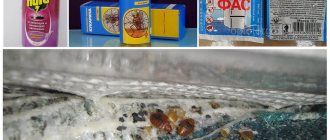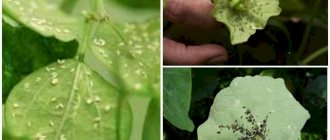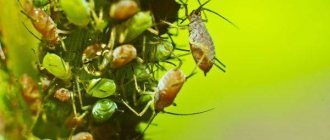The spider mite is a member of the family of arachnid arthropods of the order Thrombitiformes, and is one of the most common of the mite family. It is a soft-bodied representative of an ellipsoidal shape with a convex upper and flat lower body. Its color depends on many factors: most often spider mites are yellowish, brownish, greenish in color. Tick size: females are approximately 0.4 to 1 mm long, males are 0.3 to 0.45 mm long.
This pest reproduces very quickly: within 10–20 days from the moment the eggs are laid, individuals are considered adults. Several generations live in the web woven by ticks. Their colonies are located under fallen leaves in a pot, under clods of earth, on the back of the leaf, on the frame and windowsill. Often a flower just bought in a store can be affected by this pest, so you should not forget about a two-week quarantine.
Important! In order to prevent spider mite damage to any plant, including balsam, it is recommended to disinfect it before planting it in a pot: treat the soil with fungicides or thermally, wipe the container and tools with alcohol or a solution of potassium permanganate.
Spider mites feed on the contents of balsam cells: an adult bites off part of it, and through the hole made drinks all the juice from it. As a result of such vital activity, some cells are destroyed, and the intensity of photosynthesis decreases. In addition, spider mites can infect any representative of the flora with incurable viral infections and gray rot spores.
Balsam - what it looks like, why it’s good, the favorite of spider mites
Another name for the flower is Vanka wet.
This is due to the fact that shortly before precipitation falls, drops of water can be seen on the leaves. The main feature of the plant is its large flowers. They can be of different shades: from pink to dark red. There is balsam with two-color petals. The bush looks quite compact, with many flowers appearing on it. This makes the top of the plant look lush. New varieties of flowers appear periodically. Some of them have large, two-colored leaves. There are also varieties of balsam that have double flowers. Regardless of the appearance of the leaves and petals, the plant is a decoration for the windowsill/house area. In this case, balsam is often damaged by spider mites.
The plant requires regular care.
It is provided with watering, but in moderate amounts, since excess moisture harms the plant.
The photo shows a representative of spider mites, do not confuse it with other insects
It is believed that Wet Roly received its name due to the need for intense hydration. This is an erroneous judgment. Rather, on the contrary, the plant develops when watering is moderate. It is important to protect the flower from direct sunlight, but it grows better with sufficient lighting, but the air temperature should be within +13...+22°C. The most suitable conditions are a cool microclimate (+18°C).
The disadvantage of this plant is its low degree of resistance to parasites. On balsam there are whiteflies (in flower beds, adjacent areas), as well as mites (spider mites, including), and aphids. Pests of the arachnid class inhabit flowers, lay eggs on the underside of leaves, actively move through healthy tissues and suck out plant sap.
Spread of parasites
promotes infrequent loosening of the soil.
This is due to the fact that at the development stage it is necessary to give the plant the opportunity to take root. Violating this rule can lead to damage to the root system, which will cause the flower to stop growing and soon die.
Photo of a balsam bush on a personal plot
How to get rid of feather mites
Consider different methods of pest control:
Mechanical: pillows need to be washed at high temperature, it is recommended to ventilate them in the sun or frost, pajamas are also washed, and the room is cleaned using a vacuum cleaner. Wet cleaning also provides good results and should be done daily. After finishing cleaning, the vacuum cleaner is disinfected and the dust bag is thrown away. It is better to take things that collect dust outside the room. These include carpets and other interior items and filler contents. Chemical method. It is based on the use of aggressive substances. It is believed that the use of household detergents solves the problem. However, when infected with dust mites, it is also necessary to ensure a prolonged effect. For this purpose, insecticidal agents are used, for example, Reid, Akaritoks, Taran, Tsifoks
It is important to use mildly toxic substances to reduce the risk of negative reactions to such drugs in humans.
Traditional methods. For example, they use herbs that are not tolerated by parasites: wild rosemary, wormwood, tansy
More aggressive methods are also used: vinegar, boric acid. However, it is important to rinse items thoroughly after use. Products such as turpentine and bleach also solve the problem of dust mite infestation, but it is not recommended to use them, as they release volatile substances. In addition, a strong odor remains that cannot be completely removed. Consider treating items with a solution containing essential oils.
The room is cleaned using a vacuum cleaner.
It is better to take carpets outside the premises.
How dangerous are spider mites for Balsam?
When such a pest appears, the plant quickly loses its attractiveness. Leaves are found that have changed color and shape. With more severe infection, the volume of green mass decreases. This is due to the fact that leaves fall off when infected with an infectious disease. Parasites contribute to disruption of the process of photosynthesis and the formation of chlorophyll. The reason for this is the destruction of chloroplasts.
The mechanism of the negative impact on the plant: when the mite inserts the proboscis of the mouthparts into the plant tissue, at the same time the saliva of the parasite gets onto the damaged area. This substance contains enzymes that provoke the development of pathological processes in the structure of balsam leaves. As the spider mite sucks out the sap, the pigmented area enlarges. Here the color of the plant tissue changes.
Simultaneously
the flower withers as all the liquid is removed from the cells.
Spider mite drinks the juice of a balsam leaf
Disease susceptibility
Why does balsam develop various diseases? The main reason is the plant’s moisture-loving nature. Its stems and foliage are 50% water. The bush loves well-moistened soil and air. And the abundance of moisture creates optimal conditions for the proliferation of pathogens and pests.
Indoor balsam is especially susceptible to diseases such as downy mildew. Among the reasons for its development are poor quality of care, low temperature, too much watering (moisture from the soil does not have time to evaporate).
The disease is caused by harmful fungi. The pathogen penetrates the plant tissue with moisture, after 2-3 days the healthy bush begins to wither (the leaves become covered with a white coating, then they turn black and fall off). The control method is treatment with fungicides. You can use Baktofit, Bordeaux mixture, Vitaros.
Impatiens are also susceptible to the following diseases.
- Gray rot. Symptoms are brown spots, gray coating on the foliage and stem. The disease is caused by bacteria from contaminated soil or water. An additional risk factor is freezing of the bush, cold water for irrigation, drafts.
You can get rid of it by promptly cutting off the affected leaves and replanting the plant in a new pot. Garlic solution or Fundazol is suitable for spraying.
- Bacteriosis. The sign is watery spots on the foliage, which later spread throughout the bush. The method of control is to remove the affected leaves and then treat the bush with Bordeaux mixture.
Signs of a mite settling on a plant
Parasites prefer balsam to other plants due to the fact that it has fleshy, juicy leaves. When the first mites appear, there are no symptoms. There are no obvious signs of pests, since microscopic areas of the plant are still affected. But after a few weeks, the number of pests increases, which contributes to the appearance of the first signs of infection:
- numerous punctures on the leaves, they look like small dots (like from a needle), in these areas the leaves change color (the dots can be light or dark);
- pigmentation of large areas of tissue is noted - the plant takes on a sickly appearance, the size of spots of a different color increases;
- the edges curl;
- when there are too many pests, the leaves completely lose color, dry out, and fall off;
- on the underside of balsam leaves small formations are found - mite eggs;
- upon careful examination of the plant, you can see moving dots - these are mites, they live mainly on the leaves;
- A web is formed, and first it appears between the stem of the flower and the leaves, then it covers larger areas until the plant under it completely dies.
Spider mites come in not only white but also other colors
Flat pliers
Flat mites, or simply flat mites, are very small mites, body length from 0.25 to 0.4 mm. The body of the tick is ovoid, yellow or brick-colored. The most common are the Red flat mite , or the orange flat mite (Brevipalpus obovatus) , as well as the cactus flat mite (Brevipalpus russulus) .
They are known as pests of cacti, citrus fruits, euonymus, ficus, aucuba and other indoor plants.
These very small pests are very difficult to detect and do not form webs.
A sign of the appearance of these pests is the slow wilting of leaves, and subsequently the death of the plant.
Flat mites are also dangerous because at normal room temperatures from 18℃ to 24℃, they are able to reproduce throughout the year.
Control measures:
Wiping with a soap solution may not give positive results, so it is better to immediately spray with acaricides.
up
up
Photo of the affected Balsamina
When the pest first appears on the plant, upon closer inspection, discoloration is visible along the edges of the leaves. It may seem that the flower lacks moisture. At this stage, people often make the mistake of pouring balsam. The plant cannot tolerate this, the roots rot. Intensive watering creates unsuitable conditions for spider mites, but in this case the plant will die, even if the pests leave it. Changes in the appearance of balsam can be seen in the photo.
Mites on leaves and inflorescences of balsam. A leaf of balsam affected by a mite.
Cyclamen mite
The leaves and flowers of plants damaged by the cyclamen mite are deformed. The cyclamen mite can only be seen under a microscope. The cyclamen mite (Phyto-nemus pallidus) is a microscopic mite, with a body length of about 100-300 microns, has an oval translucent yellowish body with four pairs of legs.
The cyclamen mite settles mainly on the underside of the leaf. In a large cluster they look like a layer of dust. Most often they affect cyclamen, balsam, pelargonium and saintpaulia. In the affected plant, the edges of the leaves curl, the stems twist, and the buds wither. High humidity contributes to the defeat of the cyclamen mite.
Control measures:
Remove all affected leaves, flowers and buds. Spraying with conventional insecticides gives a poor effect; you can spray with special preparations against cyclamen mites.
What can cause balsam pain?
This plant is loved by gardeners not only for its lush greenery and beautiful flowers, but also for the absence of complex requirements when growing it. However, in some cases, balsam may become sick, which will certainly affect its appearance.
A lot depends on the quality of plant care. Impatiens love water very much, but if it grows in the cold, it is necessary to reduce watering. Otherwise, the flower will simply rot.
One of the important problems of this plant is the appearance of powdery mildew. A similar phenomenon is most often observed with high humidity, cold and improper planting. But most often, downy mildew appears on all outdoor plants at once. Sometimes entire epidemics occur, which have to be combated with comprehensive measures.
Powdery mildew is a fungal disease that spreads quickly at temperatures below 18 degrees Celsius. If, on top of everything else, it is very humid outside, the fungus will quickly penetrate the leaf tissue. A couple of days is enough for the balsam to become sick and ugly. Initially, a white coating will appear on the leaves, and then they will quickly turn black and fall off.
Under the influence of powdery mildew, balsam will stop growing. At first there may still be new leaves, but their growth will become slow. The disease is quickly transmitted to other plants, so you need to try to get rid of diseased branches immediately. In addition, it is necessary to reduce the frequency of watering, and periodically spray healthy leaves with systemic fungicides.
Any diseases that balsam may encounter are associated with insufficiently warmed air. This also applies to fungal infections such as powdery mildew, and parasitic effects, including spider mites. If the plant is kept at the correct temperature and humidity, and is also treated with special substances for preventive purposes, there should be no problems.
It must be taken into account that seedlings often become carriers of the disease. Therefore, before rooting seedlings, they must be thoroughly checked and treated to prevent the development of diseases in the future.
How to treat a plant against a pest?
Timely measures taken to destroy the pest will help save the crop. To get rid of spider mites on eggplants, different methods are used - folk recipes, specific biological and chemical agents. Each of them has its positive and negative sides.
Traditional methods
Many gardeners prefer to use traditional methods of fighting spider mites in their garden beds. There are many remedies for pests that are easy to prepare at home:
- Soap solution. 100 g of grated soap are diluted in 10 liters of water. Mix everything thoroughly and leave for a couple of hours. The prepared solution is sprayed onto the affected plants. After 3 hours, thoroughly wash the eggplants using a watering can or hose.
- Hot pepper. Stir 100 g of hot pepper well in a liter of water. Leave for 24 hours, after which diseased bushes are sprayed.
- Garlic. For 1 liter of water, take 2 pre-chopped heads of garlic and mix. Leave for 5 days, then use as directed.
- Onion peel. It is prepared in the same way as garlic infusion - 100 grams of onion peels are required per liter of water. The solution is sprayed on diseased bushes.
- Dandelion and horse sorrel roots. Stir 150 grams of herbs in a bucket of water and leave for a day. After 24 hours, the solution is filtered and the plants are treated.
Biological products
Products from this group contain specific substances that destroy mites, but are safe for humans and plants. Such preparations are easy to use, they do not accumulate in the fruits, so the harvest can be used for food after just a few days. Biological substances include:
- Aktofit. The drug acts on the insect's nerve cells, causing paralysis. The substance is used only in dry weather; in a humid environment it disintegrates. Has no effect on larvae. It is not safe for bees, so it is not used during the flowering period.
- Akarin. Soil fungus in the form of a solution with a fairly quick effect. When used correctly, the result is noticeable after a couple of days. In a week it is possible to get rid of the entire colony of spider mites.
- Bitoxibacillin. Biological agent with a quick effect. Has a detrimental effect on adults and larvae. The result appears after 3 days. A week later, the eggplants are re-treated with the product.
- Fitoverm. The main active ingredient in the composition leads to malfunctions of the tick's nervous system. After treatment, the pest dies within 10 hours. The drug acts only on adult insects, so re-treatment is carried out after a week.
- Mites. The product concentrate is diluted with water according to the instructions and used for spraying plants. The substance has a detrimental effect on adult insects and larvae. It is possible to get rid of the pest within 7 days.
Biological drugs that help cope with spider mites include Iskra Bio, Vertimek, Agravertin. The products are popular because they are cheap and safe for plants and humans.
Insectoacaricides of chemical origin
If simple control measures do not help with spider mites, then stronger drugs are chosen. To get rid of harmful insects, chemicals are often used. Such drugs are used strictly according to the instructions; if used incorrectly, the substances are harmful to animals and people. Insectoacaricides include:
- Floromite. The product destroys adult insects and larvae, the effect is noticeable after 2-3 days. It is permissible to process eggplants only 2 times during the entire period of growth, flowering and fruiting. Protects bushes for 3 weeks.
- Sunmite. When used correctly, the drug can get rid of all types of ticks. The effect is noticeable 60 minutes after treatment and lasts for 6 weeks. The product is not washed off by rain, however, use is possible only after the bushes have finished flowering.
- Nissan. A less effective remedy, however, after a week and a half all ticks will die. It is acceptable to use to get rid of larvae.
- Colloidal sulfur. The product combats the effects of the pest on the plant. However, it will not be possible to completely get rid of the insect using sulfur. Less effective in dry times.
- Actellik. A good product that destroys pest colonies by the end of the first day. The solution is used very carefully due to increased toxicity.
How to identify?
Impatiens is one of the favorite delicacies of spider mites; its green leaves and succulent stems attract the pest first of all flowers.
This parasite is very difficult to detect. Most often, the grower begins to fight the pest at the moment when the plant has already been seriously damaged. The main sign of the presence of spider mites on balsam is the presence of small black dots on the leaves (bite marks) and the presence of a thin film - cobwebs.
With severe damage, the leaves turn white, the flower is shrouded in cobwebs, and at the tips of its leaves you can see a cluster of moving pest bodies. At the last stage, balsam loses its leaves and flowers without producing new ones.
It will not be possible to detect this pest on your pet with the naked eye: it is too small, and their color matches the color of the leaves. You can only see the female: she is larger than the male, and she is red.
Why do the buds fall off?
Often, beginning flower growers are faced with situations when the “Vanka wet” flower begins to shed its buds. The main reasons for this phenomenon include violations of temperature and humidity conditions, excess nitrogen in the soil mixture and potassium deficiency. Another reason that can cause buds to fall off is a draft. Impatiens are very sensitive to drafts and cold snaps, which are stress factors for them. It is also necessary to check the condition of the soil mixture in the pot. It should not be over-moistened.
Despite the fact that this flower loves regular watering, excess moisture in the soil can cause its roots to die and the buds to fall off.
Balsam's diseases
Impatiens, if they are well cared for, do not get sick more often than other indoor plants. But gross violations of the conditions of keeping the flower can lead to dire consequences.
Root rot
If moisture often stagnates in the soil, this can lead to diseases of the root system - the so-called Root Rot. At the first signs of disease, the plant can still be saved. Remove damaged roots and replant the plant in new soil with good drainage.
Gray rot
If brown spots appear on the leaves, and the stems become covered with a white coating and begin to wither, the plant has become infected with a fungal infection called Gray rot. Infection occurs only if the watering regime and other vital indicators of maintenance are violated.
In any case, you should urgently transplant the flower into a new substrate suitable in composition for Balsam. Check the pot for drainage holes and a layer of expanded clay. Water the flower with a solution of “Fitosporin” or some fungicide against rot and fungal infection. Do not allow water to stagnate in the pan after watering. Use soft, settled water at room temperature.
Powdery mildew
In a hot, dry room with stagnant water in the pan, Balsam runs the risk of contracting a disease such as powdery mildew. The pathogen enters the plant along with moisture. After three to four days, spots with a whitish coating appear on the stems. It is precisely by this whitish coating (mycelium) that an infected plant can be recognized. Droplets of liquid appear on the leaves after the spores ripen. Hence the name of the disease - powdery mildew. The lower leaves are affected first - they begin to darken and fall off. Soon, the plaque will cover the entire plant. The balsam may die.
Stop watering the plant. Remove all affected parts of the flower. Spray the flower with a suitable fungicide for powdery mildew (Skor, Fundazol, Topaz). Treating a diseased plant with solutions of copper sulfate, soap solution, and soda ash also helps. It is advisable to feed the bush with phosphorus-potassium fertilizers or, better yet, replant it in new nutrient soil.
Bacteriosis
Also, due to excess moisture at low temperatures, the leaves of Balsam may become covered with black spots. This dangerous disease is called Bacteriosis. It cannot be treated - the bush must be destroyed so that other plants do not become infected.
Bronzing
Bronzing is another untreatable disease of Balsam. The disease is recognized by wilting leaves and stems, deformation of the leaves, and the formation of holes of different sizes on them. The diseased plant should be destroyed.
Mosaic
Insect pests are sometimes carriers of diseases such as Mosaic. The leaves become deformed, yellow spots appear on them, the stem begins to wither, and flower growth stops. It is necessary to get rid of parasites on the plant with the help of insecticides, and then try to bring the flower to its normal appearance by pruning the affected areas, replanting it in new soil and careful care. Sometimes it is not possible to save a flower.
We have described almost all the diseases that indoor Balsam can suffer from. At the first signs of illness, begin treatment and take measures to prevent the disease from spreading to other flowers.
Other growing problems
But, if Balsam is grown incorrectly, other problems of a non-infectious nature also occur. Let's consider them too.
If the Balsam suddenly began to shed its leaves, turn yellow and wither, then this is the first sign that it was stressed: there was a sharp fluctuation in temperature, or the lighting changed for the worse, or the flower was forgotten to be removed from a cold draft when ventilating the room, or it became cramped in the room. tiny pot. Analyze all options and correct errors immediately.
This may be interesting: Lantana - description, types and varieties
With a lack of light and heat, Balsam leaves will curl and fall off. The plant will not bloom. Eliminate the deficiencies in care, and the Balsam will grow new leaves. Similar symptoms occur if an old pot becomes too small for Balsam - it grows out of it. The plant should be transplanted into a suitable container.
What are the problems with sheet plates and why?
Drying
There may be several reasons for this illness:
- Spider mite infestation. You can get rid of the pest using insecticidal preparations, and one treatment will not be enough; the mite larvae persist and, after a while, begin to have a harmful effect again. Therefore, it is recommended to carry out treatment every week until the parasite disappears completely.
- The indoor air is too dry. If the pot is located close to the heating radiator, you should move it to another, cooler place. The main thing is to ensure that the temperature is not too low. From the cold, balsam sheds its leaves.
- Low indoor air humidity. To correct the situation, you need to spray the area around the plant twice a day.
- If the balsam is not replanted for a long time, it, having taken from the soil all the substances necessary for healthy development, begins to suffer from their deficiency. In this case, fertilizing or replanting will help.
- Leaves exposed to direct sunlight get burned and dry out. Impatiens are best kept in partial shade.
- If the soil is too dense or the earthen ball is too hard due to lack of watering, the roots cannot fully develop. Because of this, the balsam may dry out.
What diseases and pests of balsam can destroy a flower, as well as the causes of their occurrence and control measures, read here.
Important! Dried leaves must be removed from the plant and resuscitation measures must begin as soon as possible.
Turning white
The reasons why balsam loses the intensity of foliage color may be as follows:
- The plant is burned by intense sunlight. To provide the balsam with comfortable conditions, it needs to be shaded.
- There is not enough nitrogen fertilizer. The problem can be solved by applying appropriate fertilizing.
- Insufficient lighting. The photosynthesis process does not start.
- If the leaves have acquired a whitish tint due to plaque, then they are affected by powdery mildew. This is a fungal infection that occurs due to excessive humidity. You can help the plant by using fungicides.
Fall off
The most likely causes of the problem:
- Plant infestation with whitefly. The larvae, in the form of small white grains, should be looked for on the back of the leaf. You can help the plant with insecticides.
- A sharp change in temperature or a change in living conditions puts balsam into a state of stress. A completely healthy plant against this background can shed its leaves. It is necessary to protect the flower from unfavorable factors, or, if it has already been damaged, not to disturb it and allow it to recover.
- The correct watering regime for balsam is as the top layer of soil dries. Waterlogged soil can cause leaves to drop.
- Dry soil can also cause leaf loss.
- If the balsam does not have enough light, instead of decorative branches you will see long bare shoots. If necessary, the plant needs to be illuminated.
- A lack of nutrients in the soil or complete absorption of the substrate by the roots also leads to the shedding of leaves. In this case, the flower needs to be fed or replanted.
Why balsam buds and flowers fall off, as well as ways to solve and prevent this problem, read here.
Covered with spots
Causes of the defect:
- Drops of water hitting the plant. It is not recommended to spray balsam directly on the leaves.
- Mechanical damage due to the activity of pests. Parasites must be removed and balsam treated with insecticides
- Spots can be symptoms of fungal infections that occur in conditions of high humidity, excess nitrogen in the soil and sudden temperature changes. Reducing watering, adjusting housing conditions, and treating with fungicides helps stop the disease.
Why the leaves of indoor balsam turn yellow and how to revive the plant can be found here.
Curl up
This symptom signals that the plant is infected with mites. Dry warm air provokes the proliferation of pests. The problem can be solved by using systemic insecticidal preparations and adjusting the conditions of detention.
Attention! The pot with balsam should be placed away from heating devices and the air in the room should be humidified.
Parasites: diagnosis, causes and actions
Impatiens are most often affected by mites - these are annoying small parasites that suck all the juice from the stem. Also dangerous to the plant are aphids, thrips and whiteflies.
Tick infestation
Characteristic signs can be noticed when examining the back of the leaf or internodes. Symptoms of spider mite infestation are a thin white film and small dots on the foliage, loss of shine, and a decrease in the intensity of flowering. The reasons for the appearance are high room temperature and low humidity levels. How to deal with spider mites on balsam?
Trimming affected parts.
- Treating the bush with a soap solution (it is preferable to dilute tar soap in water). Apply foam to the plant, rinse after 5-10 minutes. Repeat the procedure after 7 days.
- With a high degree of infection, treatment with chemicals is required. Their list includes Fitoverm, Vertimek. Select the dosage according to the instructions.
Impatiens can also be parasitized by cyclamen mites. It deforms young leaves, lateral buds and shoots. The plant loses its growth points and quickly dies. You can get rid of the pest only by treating it with acaricides.
Aphid
The insect sucks the juice from the leaves, then they become deformed and growth stops. With a high degree of damage , the process of photosynthesis is impossible; as a result, balsam stops developing normally and dies.
It is quite difficult to notice an infestation on a bush, but aphid nests made of whitish plaque are clearly visible on the walls of the pot.
Important! The reason for the development is improper care and irregular watering (the pest multiplies in dry soil).
Aphids can be identified during transplantation or inspection of the root system. Folk methods of struggle are tinctures of tobacco leaves, onion peels and wormwood. Also, the infected bush can be treated with ash, tobacco dust or a mixture of ash and soap.
How to fight aphids? Chemicals for saving balsam - Fas, Decis, Actellik. Dosage and application characteristics depend on the size of the plant (use according to instructions). When treating with chemicals, be sure to cover the soil in the pot with film.
Detailed algorithm of actions:
- Removing damaged and shrunken fragments.
- Treatment of cut parts with insecticides. Spraying the bush with a solution of dried tobacco and tansy grass.
- Completely change the soil in the pot and disinfect the pot itself.
Whitefly
In appearance, the insect resembles a small white moth. The breeding period (from laying eggs to hatching of the individual) is 35-40 days.
The whitefly lays eggs on the back of the leaf , and later these eggs hatch into larvae that eat the entire balsam bush.
Over time, the skin of the larvae hardens, and individuals become invulnerable to certain chemicals. Therefore, it is necessary to process the plant several times, observing a break of 4-6 days.
Symptoms of infection - the foliage loses its green color , yellow spots appear on it, and later it dries out and falls off. A dangerous consequence is the complete death of the plant.
Reference. The whitefly also secretes a liquid with a sugary consistency, which contains sooty fungus pathogens.
How to kill whiteflies?
- Regular shower. Eggs and larvae can be washed off with water pressure. It is important to process both sides of the sheet.
- Removing the affected parts of the bush.
- Destruction of individuals using insecticides. Flower growers recommend using Karbofos, Tanrek, Actellik. These are poisonous drugs that are prohibited from being sprayed in an apartment. The procedure must be carried out on the balcony or on the street.
- An alternative to chemicals is home remedies. You can treat balsam with tincture of grated garlic. To prepare, you need to chop 1-2 cloves and turn them into a paste. Pour boiling water and leave for up to 3 hours. Use for spraying 2 times a day.
Thrips
Insects pose a double threat: they weaken the bush, being a pest, and are also carriers of the mosaic virus, a dangerous disease of indoor balsam. The problem can be diagnosed by the deformation of young leaves at the top and a change in the growing point.
The greater the impact of pests, the worse the appearance of the flowers. The edges begin to dry, and living insects can be seen in the center of the corolla.
The main method of combating them is to remove infected fragments and subsequent treatment with insecticides. It is important to isolate the affected bush from the rest. You need to spray the plant with Tanrek or Actellik.
Tanrek should be diluted in a proportion of 1 ml per 5 l or 2 ml per 10 l (the drug must be measured with a syringe). Actellik dosage for severe infection: 1 ampoule per 1 liter of water. The spraying procedure should be repeated after 5-7 days.
What kind of pest is this?
The insect has the smallest dimensions (maximum length - 1 mm). The tick's body shape resembles an ellipse. Pests live in large colonies, building houses for themselves under clods of earth, under leaves that have fallen into a pot, or on the back of a leaf.
The group of ticks has more than 100 subspecies, the distinctive feature of which is rapid reproduction. The adult bites off part of the leaf, and then drinks all the juice from it through the hole made.
REFERENCE! A female tick lives only 15 days, but this time is enough for her to lay an average of 100 eggs. And newcomers to the clutch appear within 3-4 days.
Also, mite eggs can remain viable for up to 5 years, hiding deep in the stem, in the frame above the pot, in the recesses of the pot.
Possible consequences
After 2-3 weeks of mite infestation, the grower can see characteristic consequences. On their list:
- the foliage is enveloped in fibers of a thin web;
- the stem has a bronze-gray tint;
- flowers wither and fall off;
- the foliage turns yellow en masse (read about why the leaves of indoor balsam turn yellow and how to help it).
The balsam drops all its leaves and stops blooming (you can find out why indoor balsam does not bloom, but only its leaves grow, here). The florist notices deformation of the bush and stunting of growth. The most dangerous consequence is the death of the plant.
Brief description of the plant
The subspecies belongs to perennial crops. Its other names are common among the people - Vanka wet, Touchy (due to its whimsicalness to the conditions of detention). The stem of the balsam is bushy and succulent, the leaf shape is oval, the edges have a jagged edge.
The plant blooms from May to December. The inflorescences are distinguished by their irregular shape. Their shade depends on the specific variety: white, yellow, red (flowers are also single and two-colored). The natural habitat of balsam is the subtropics and tropics of Africa and Asia.
How to fight at home
There are two ways to fight spider mites: by resorting to chemicals or using folk remedies. It all depends on the degree of infection of the plant.
Acaricides
Acaricides are chemicals designed to kill mites on crops. Effectively affects parasites of animals and birds.
Aktellik
Actellik is a chemical substance of the second hazard class, toxic to people, animals, and birds. Completely safe for plants.
When balsam is treated with Actellik solution, the active ingredients of the drug enter the sap of the plant, thereby destroying spider mites in hard-to-reach places. Also, pests are destroyed by the vapors of the drug, the result can be seen the very next day. One ampoule of the drug is diluted in two liters of water.
The disadvantage of Actellik is its strong, unpleasant odor. Therefore, it is better to treat the plant on the balcony with the windows open.
Sunmite
Sunmite is an odorless anti-tick product that is ideal for treating indoor plants. When spraying, it is necessary to treat the leaves, stems and top layer of soil. Sunmite destroys eggs, larvae, and adult insects within four hours and continues its effect for three days.
One gram of powder must be diluted in a liter of water. After treatment, the remaining product cannot be stored further.
Apollo
Apollo is considered one of the effective preparations. It fights against many types of mites; when sprayed, it destroys not only adult insects, but also their larvae. This product is not hazardous to pets or people. But when treating a plant, as with any acaricide, do not forget about safety rules. Dilute one drop of the drug in a liter of water.
Rules of application
If there is a need to use acaricides at home, you should follow several rules.
- First you need to prepare your workplace, remove unnecessary objects and food from the surface.
- Wear rubber gloves and a respirator.
- Before starting to prepare the solution, read the instructions
- When spraying acaricides, there should be no people or pets in the room.
- It is necessary to treat not only the plant, but also the place where the flower was located. Two hours after treatment, ventilate the room and do a wet cleaning.
Treatment with folk remedies
Not all indoor plant lovers resort to using chemicals to combat spider mites. Many people prefer proven folk remedies.
Before using the infusion, it is necessary to remove leaves and flowers damaged by mites. Rinse the plant with a warm shower; After the balsam leaves have dried, treat with a folk remedy.
On a note! If an indoor flower is infected, you should inspect nearby plants for infection. Afterwards, do preventative spraying.
Garlic composition
One of the popular folk remedies for pest control is garlic infusion, which is not difficult to prepare.
Pass a small head of garlic through a press. Transfer the resulting slurry to a jar, pour 0.5 liters of water into the container, and close with a nylon lid. Keep the garlic infusion in a dark place for five days. Afterwards, strain the mixture, dilute it with water one to one, and treat the plants.
Dandelion roots
An infusion of dandelion roots is popular among gardeners. In this recipe, the root of the plant can be replaced with leaves.
Heat five liters of water to 40 degrees, add four hundred grams of crushed dandelion root. Cover the container with the liquid and let it brew for three hours. Afterwards, strain the broth through cheesecloth or a fine sieve. Treat the plants with the resulting decoction.
Chemicals to combat spider mites on indoor flowers
Therefore, it is necessary to treat plants and soil against spider mites with special insecticides:
- Fitoverm
, which is a biological product created on the basis of plant extracts.
The substance is practically non-toxic to humans and pets, so it can be used to treat plants indoors. Fitoverm can be used for preventive treatments or to control pests that settle on domestic flowers. The drug begins to affect ticks approximately 6 hours after spraying. Fitoverm has a protective effect for up to 3 weeks. The working liquid is diluted as follows: 4 ml (2 ampoules) are diluted in 2 liters of water, treatment is carried out immediately after dilution, abundantly irrigating the foliage on both sides. - Aktara
– this insecticide can be used not only to treat vegetable plants, but also to control pests on indoor flowers (roses, violets, ficuses and many others). The product is available in the form of soluble granules or concentrated emulsion. Small packages of the substance - in ampoules or small bags - are perfect for treating houseplants. When sprayed, this drug penetrates into the foliage cells, and the mites, sucking out the cell sap, simultaneously eat a dose of the toxic substance. After 60 minutes, these pests lose the ability to eat, and after 24 hours they die of starvation. Once in the ground, Atkara is able to protect indoor flowers for up to 60 days. And for spraying, you should prepare a fresh solution each time. The substance is quite toxic, so you need to wear rubber gloves when working with it; after treatment, you need to thoroughly wash your face and hands.
- Plant-Pin
is a fertilizer produced in the form of sticks; its main active ingredient is butoxycarboxim. Sticks are stuck into the soil in pots, their number depends on the volume of the container - for a pot diameter of 9 cm, 1 stick is enough, for 12 cm - 2 sticks. At least 5 sticks are stuck into 20 cm containers. The distance from the sticks to the plant should be at least 3 cm. Watering helps dissolve this drug, which enters the root system of the flowers. Plant-Peak begins to act after 4-6 days and protects flowers for 2 months.
How to protect balsam from diseases and pests
To prevent the appearance of parasitic individuals on the flower or the development of diseases, it is necessary to provide proper care for the plant. To do this, it is recommended to follow the following rules:
Flowerpots should be placed on a south or east window, where there is more sunlight, but you should make sure that the plant does not get direct rays of light during the midday heat; it is necessary to shade it;
Completely healthy balsam flowering (photo)
Watering of the plant should be controlled, carried out periodically, abundantly, but not overwatered until a swampy substrate forms. To prevent this from happening, when planting in a flowerpot, place 2-3 cm of drainage on the bottom;
In winter, during rest periods, the frequency of watering is reduced. In addition, it is necessary to move the plant to a cooler place where the temperature will not drop below +15 C;
It is worth spraying the plant periodically, but so that the moisture gets only onto the leaf blades. It is undesirable for the inflorescences to get water. This can cause the flower to rot;
In spring, pinching of young plants and fresh shoots is mandatory. Thanks to this, the flower begins to branch, grows in size and color;
Old shoots and faded buds should be removed to give the plant strength to continue to grow and develop. The latter take all the nutrients and become saturated with moisture, but do not grow and bloom;
During the growing season from the first days of March to the end of December, it is necessary to periodically feed the plant once every 14-21 days. The most favorable fertilizers should be those containing nitrogen and phosphorus.
Bright flowering balsam (photo)
Constant care of the plant and monitoring its condition will allow you to enjoy the blooming of the original flower for a long time. When you detect the first symptoms of damage or invasion of parasites, it is advisable to immediately begin exposure.
Delay in this situation can negatively affect the flower or completely destroy it.
While watching the video you will learn about growing balsam.
Thus, balsam is the plant that spider mites, aphids and thrips most like to inhabit. To eliminate them, it is necessary to irrigate the plant with chemical insecticides.
To protect the bush from the possibility of becoming infected with diseases, and especially gray rot, it is necessary to follow the rules for care and cultivation.
Why does balsam wither and dry out?
Withering and drying of the plant is a common result of improper care. At the same time, both deficiency and excess moisture in the air and soil mixture can cause such a problem. To restore the appearance of a plant damaged by drought, it is enough to resume the previous watering regime. But the soil should not be allowed to become waterlogged, so as not to destroy the roots.
Another reason for balsam wilting is often a lack of nutrients. In this case, you can give strength to the plant by feeding it with humic fertilizers. Flower growers also claim that in some cases iodine will help eliminate the painful appearance of a flower. To do this, use a solution of 2 drops of iodine and 2 liters of water no more than once a month.
This solution (about 50 ml per plant) is carefully poured onto the soil near the walls of the pot so as not to burn the root system
Prevention
It is possible to rid a plant of spider mites, but the appearance of this pest will have a detrimental effect on the flower. Therefore, it is easier to prevent the appearance of a parasite than to try to get rid of it.
There are several rules that will help prevent balsam from becoming infected:
- Inspect the plants every day to identify the first signs of a mite.
- Wipe the leaves of the flower with a damp cloth twice a week. During the process, rinse the fabric in hot water.
- Monitor watering of the plant and do not let the soil dry out.
- Spray regularly. Dry air and lack of moisture can lead to spider mites.
- Apply fertilizers on time.
- Keep the soil surface clean and promptly remove fallen leaves.
- It is not recommended to place a newly purchased indoor plant next to other flowers. First, you need to make sure that the plant is not infected; to do this, the pot with the flower is isolated from other plants for three weeks.
Various drugs
There are general rules for all drugs:
- It is advisable to carry out the treatment in the fresh air, if this is not possible, in a very well-ventilated area.
- Use gloves. If necessary, use a mask. The recommendation for personal protective equipment is on the packaging of all drugs, but not all gardeners follow them.
- Clothes after treatment should be washed; surfaces on which the product may have come into contact should be washed thoroughly.
- Under no circumstances should it be disposed of in the apartment.
- Most products are contact, that is, pests die when they come into contact with the drug. Conclusion: you need to carefully treat the surfaces.
About the tools themselves:
- Actellik is a very powerful “killer” agent that will reliably get rid of ticks on a lemon. Acts on arachnids. It is recommended if plants are heavily and extensively affected by mites. The drug is extremely toxic, with a pungent odor.
- Neoron is a universal substance that can destroy both adults and eggs. One procedure, of course, is not enough, but two, as a rule, are enough to completely get rid of pests.
- Fitoverm is a fairly well-known drug because it is less toxic than others. It is perfectly acceptable (though not advisable) to spray it on plants in the bathroom. Affected lemons are treated with Fitoverm 3-4 times, at intervals of a week.
- Sunmite is similar in action to Neoron. The Japanese drug in powder form is very effective against ticks at any stage of development, but it is used on one plant no more than once a year, otherwise the ticks get used to it. Disadvantage: rarely found on sale.
- Aktofit is used mainly by greenhouses for treating open ground plants, but can also be used for indoor plants. The tick will require 1-2 treatments, at the rate of 4 ml of the drug per 1 liter of liquid.
- Aktara - the drug is not claimed to act against spider mites, it is an insecticide, it works against insects. However, in practice, many note that Aktara is really effective: after spilling a clod of earth with an affected tree, the mites disappear.
- Nissoran is a drug in powder form. Effective on all stages of ticks, except adult ones. That is, it will get rid of eggs, larvae, and nymphs of spider mites. It has a long-lasting effect (up to 1.5 months) and is non-phytotoxic. It is effective to use before there are too many adults. The result will be noticeable after 10 days (this is the period during which adult pests die of natural causes).
- Akarin is a drug in ampoules, characterized by a high speed of action, it affects ticks after 8-16 hours (on gnawing pests - after 4 hours).
- Apollo is a liquid drug that is rarely found on sale. However, it is popular among advanced gardeners in the fight against mites, because it is designed to protect the plant specifically from them and is able to act on eggs and larvae. The drug does not affect adult individuals, however, depriving them of the opportunity to reproduce (remember that the lifespan of a spider mite is from 30 hours to 8 days), quickly leads to the complete death of the parasites. The drug does not act once, but over a prolonged period; as a rule, 1-2 treatments are sufficient.
- Vermitek - dissolve 2.5-3 ml in 10 liters of water. Spray the plant, then wrap it in polyethylene and remove it after a day. The drug penetrates the flower tissue, thereby ensuring activity even after treatment.
- Agravertine - used against spider mites and many pests of open ground, for example, the Colorado potato beetle. Unlike most of the listed drugs, which act on the digestion of pests, it attacks their nervous system, causing paralysis. The parasites stop moving 6 hours after treatment and die within 2-3 days. To treat indoor lemons, dilute 5 ml per 1 liter of water.
Very poisonous drugs include those containing carbosulfan; it is better not to use them (Marshal drug).
Preparations in powder form do not always “stick” to plants well, so you can first spray the affected areas with stimulants (it is advisable to combine them with acaricides, that is, the above drugs), for example Epin or Zircon, and then treat them with powder.
Why do the leaves curl?
There may be several reasons.
- Curling and deformation of leaves often indicate that the flower lacks moisture and light. These indoor plants do not tolerate lack of watering and darkness.
- Very dry air in the room can also cause leaves to curl. In this case, spraying allows you to restore their previous appearance.
- Direct sunlight can negatively affect the condition of leaves. To protect the plant from sunburn, it needs to be provided with soft but sufficient lighting. In hot and sunny weather, it is recommended to shade balsams.
Important! Having noticed that the plant is dying, and the shape of its leaves has changed greatly, it is important to carefully examine the flower for the presence of pests or traces of disease. It is best to inspect a problem plant using a magnifying glass.
How to save a frozen plant?
Drafts and low temperatures are detrimental to delicate balsams. If they caused the plant to die, you can try to correct the situation. To do this, all frostbitten parts of the flower are removed and trimmed down to living and healthy tissue, after which watering is temporarily reduced. While the affected balsam is sick, it is provided with extremely gentle conditions. In some cases, gardeners save the plant in a radical way, dividing it into cuttings.
Frostbitten leaves on cuttings, as in the previous case, are removed and trimmed to undamaged tissue.
Preventing the appearance of parasites in the apartment
Following preventive measures will help save plants and prevent pests:
- regularly check flowers for damage and parasites;
- keep new plants in quarantine for 2 weeks;
- install mosquito nets on the windows;
- do not allow the flower to dry out, spray it regularly, since mites cannot tolerate high humidity;
- remove fallen leaves and buds in a timely manner;
- carry out preventive treatment with protective drugs, wipe the leaves;
- disinfect the soil before transplanting flowers (freeze or evaporate).
To avoid the appearance of pests on your home flowers, provide them with proper care, periodically bathe them and carry out preventive treatment.
Spider mites are a dangerous pest that in a short time can form a large colony of parasites that destroy house plants. Insecticides and folk remedies will help preserve the beauty on the windowsill. To prevent the problem from recurring, follow preventive measures, create unfavorable conditions for insects and provide proper care for the flowers.

